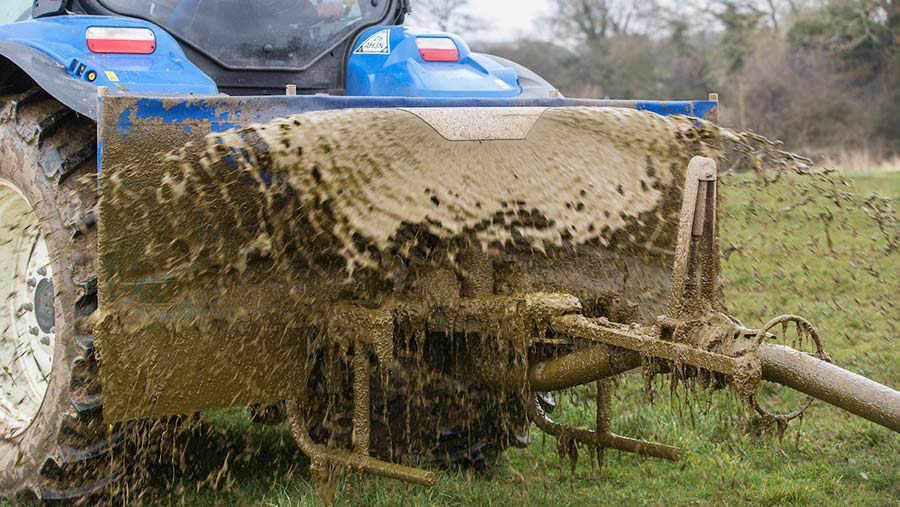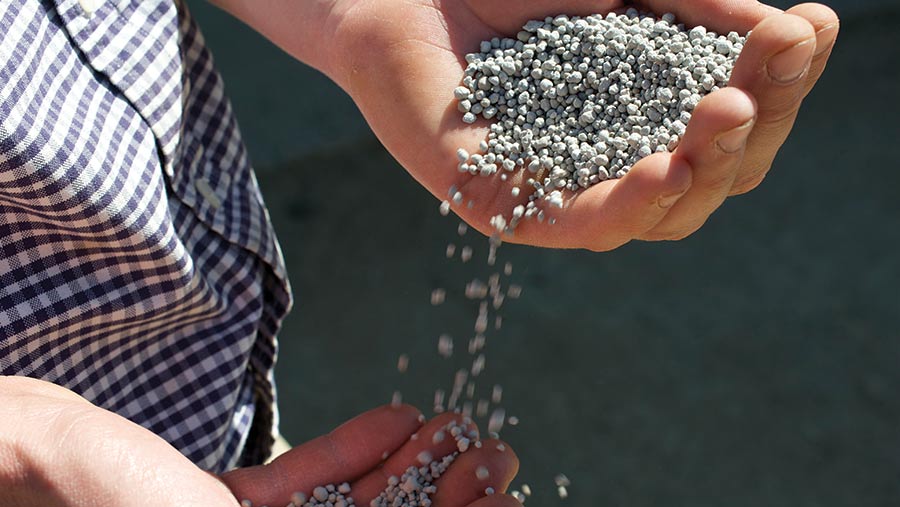Guide to safe storage and spreading of slurry and fertiliser
 © Tim Scrivener
© Tim Scrivener Farmers are coming under increasing environmental pressure when it comes to safe use of manures and fertilisers.
New legislation requires all farmers to meet Nitrate Vulnerable Zone standards, whether they are within an NVZ or not.
It is key that the farmer is responsible for correct storage and application and does not reply on contractors to adhere to the necessary rules, abdicating liability.
And while anyone applying herbicides, insecticides or fungicides must hold a certificate in their safe use, there has not been any equivalent accredited training for handling fertiliser and manure. Until now.
Olivia Cooper attended a Lantra course to find out how to safely apply fertiliser and manures.
See also: Guide to fertiliser terminology and spreading equipment
How to minimise slurry and fertiliser water pollution
Rules
Farmers are under a legal obligation not to pollute waterways or to cause a public nuisance through smell, for example. Identifying point-source pollution, where nutrients enter a watercourse from a specific site, is relatively easy.
Diffuse pollution, which occurs when nutrients leach into surface and groundwater from multiple sources, is more difficult to pinpoint but is a major environmental problem.
Consequence
In England and Wales about 60% of nitrates and 25% of phosphates in our waters originates from agricultural activities. This can harm aquatic life and contaminate drinking water.
In addition, 95% of EU ammonia emissions – affecting air and water quality – come from agriculture, leading to new air pollution targets being imposed. Of course, lost nutrients present a financial loss to farmers as well.
It is ever more likely that splash plate slurry application is a method which is likely to be phased out to reduce the risk.
Advice
- Spread when the conditions are right – not when land is saturated, frozen, or cracked through to land drains
- Avoid spreading on hot or windy days, and only spread when the crop is actively growing
- Spread liquids as close to the crop as possible
- Use cover crops to lock up nutrients and prevent runoff from bare soils
- Avoid spreading on compacted or steeply sloping soils
- Incorporate manures within six to 24 hours
- Produce risk maps, analyse soil and only apply what is required.
Rules on spreading near watercourses or in NVZs
Rules
About 58% of England and Wales is designated as a NVZ, and the new Farming Rules for Water, introduced in April 2018, require every farmer to work to similar standards.
Consequence
Failure to comply with this legislation puts your BPS at risk, and you may also be prosecuted for causing environmental damage.
It is the occupier who is held responsible, not a contractor, so ensure tractor drivers are given appropriate maps and clear direction.
Advice
- To adhere to ‘Farming Rules for Water’ in relation to fertiliser and manure, farmers and contractors need to apply according to a Nutrient Management Plan to avoid nutrient overload
- Maintain a 2m green buffer strip from the centre of a watercourse or dry ditch or 1m from the edge of the bank
- If you spread organic manure (livestock manure), keep a risk map of your holding
- Do not apply inorganic nitrogen (manufactured) within 2m of surface water
- Do not apply organic manure within 10m of surface water (6m if using precision application equipment) or 50m of a spring, well or borehole
- Do not spread if there is a significant risk of pollution
- NVZ closed periods – do not spread inorganic fertiliser from 1 September to 15 January (with some exceptions). Organic manures with more than 30% readily available nitrogen must not be spread between 1 August and 31 January (depending on soil type and cropping)
- NVZ max: In any 12 months the most nitrogen you can apply from organic manures is 250kg/ha, with a whole-farm average of max 170kg/ha.
Advice for correct storage and handling

Choosing a high-quality fertiliser ensures more even application
Rules
Storage of fertiliser and manures is covered by a range of legislation including the Storing Silage, Slurry and Agricultural Fuel Oil (SSAFO) rules, the Control of Pollution Act 1989 and the Dangerous Substances Regulations 1990.
Sufficient and SSAFO-compliant slurry storage capacity is vital, and is something too many farms don’t have.
Consequence
Inorganic fertiliser is extremely hazardous and potentially explosive, so accidents can lead to devastating environmental, financial, and human losses. Organic manure is also highly polluting and can emit lethal gases – killing two to three farmers every year.
Advice
Inorganic fertiliser:
- Keep an inventory of fertiliser stored, and report losses to the police
- Store in a secure place away from public access and watercourses
- Don’t store near heat sources or combustible material such as straw
- It is a legal requirement to notify the local fire brigade and Health and Safety Executive if storing 25t or more of AN
- Stack bags a maximum of three high and overlap for stability
- Don’t lift broken bags and use rounded tines for lifting on the forklift to help prevent piercing bags
- Liquid fertilisers must be in lockable, watertight containers designed for purpose
- These should be clearly labelled and ideally bunded to prevent leakage.
- Ensure tractor operators are trained and machinery is well maintained.
Organic manures: (These are NVZ rules but should be followed by all)
- Solid manure can be stored in temporary field heaps, providing it can be stacked and doesn’t leak liquid effluent
- It must not be within 10m of surface water or land drains, or 50m of a spring, well or borehole
- Don’t locate it in the same place each year – move to a new location and leave a two-year gap before returning to a site
- You should have sufficient capacity to store all liquid manures and dirty water from 1 October to 1 April (depending on slurry type)
- Consider using grant schemes to cover slurry stores and divert clean water away
- Ensure tractor operators are trained – it is easy to overturn slurry tankers when fully loaded.
Health and safety – advice on dealing with spillages
- Wear gloves and eye protection when handling fertilisers – rats are common in stores and carry leptospirosis, while chemicals can cause burns
- If you spill fertiliser, clean it up and return to the spinner, spread thinly on crops or add to the slurry/manure store
- Have an emergency action plan in place – identify vulnerable watercourses or groundwater, consider blocking drains and damming watercourses in the event of a spillage, and identify who to contact in emergencies (Environment Agency and fire brigade)
- Do not wash down spillages with water unless advised to do so
- Keep a record of what’s in the tank – take a photo of the label on your phone
- Use sand or earth to soak up liquid spills, not sawdust because it is flammable
- Slurry and digestate can release lethal gases – do not enter enclosed stores and consider installing gas alarms. Often rescuers succumb to gases so draw up an emergency action plan.
